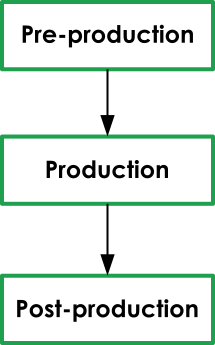My Process


The design process for any person and any project can be messy, confusing, and convoluted. It can be long, tedious, and difficult. But there is never any reason to have an overly complicated, difficult to understand design process. That's why I distilled my process into three main steps, the same steps followed by most anyone who works in video and audio production. I apply this process to all of the work I do because it makes the design process easier for all parties involved, both in terms of work and in terms of making sure the finished product is high-quality and does all it is supposed to.
Step One: Pre-Production
The first step in my design process is to determine the needs of the project and to pitch my vision for it. This is done through meeting with the client, and having detailed discussions on what they want to accomplish with the project. What are they looking for? Who is their target audience? How does this tie in with other work you do, and with the image you want to project? These and other questions are very important in the initial stages of design because they help to set the stage.
In addition to these discussions, another vital part of this step is to design mockups of the project. In most media production, this is generally done through story pitching and storyboarding. In addition to these techniques, depending on the type of project I am working on, I also create rough mockups and wireframes in order to show precisely what my vision for the project is. Once the client has accepted my intentions for the project, I move to the second step: Production.
Step Two: Production
Production is the real nuts and bolts when it comes to any project. You have to determine the best way to achieve your vision within any and all constraints, and, as such, it often makes you a better designer. No matter how familiar you are with the products and programs you use, every project brings unique challenges that force you to expand your knowledge. Research is an integral part of this process because there will always be aspects that challenge you in ways you could not foresee. This is one of the more rewarding aspects of media production because it forces you to address weaknesses you didn't know you had.
Another vital part of this step (and in fact the entire design process) is to give the client frequent progress updates. Having worked on both sides of the production process, I know all too well how important it is to let the client see that progress is being made, even if things are moving slower than anticipated. Depending on the project, this could be rough cuts of video or audio, sharing new ideas for the project, graphical updates, and letting the view the last version of the project such as uploading a website to a test server. Not only does this provide the client with a way to see what the designer is doing, it helps to provide the designer with valuable feedback. In addition, for interactive projects such as websites, it is critical to test the project on a wide assortment of devices so that potential functionality issues can be minimized.
When Production on the project winds down and the project is delivered to the client, I move into the final phase: Post-Production.
Step Three: Post-Production
A lot of people think that once you deliver the project to the client, your work is done. I couldn't disagree more. Any number of things could happen after this point, which means that the design process doesn't really end until all parties are satisfied of the quality and functionality of the project. This is especially important in interactive projects such as websites, where you can't predict every single thing that could happen. The Post-Production phase is dedicated to weeding out any problems that might crop up, meaning that continued contact with the client is imperative. They will be able to see more clearly if the product isn't working correctly, if their audience isn't responding to it, or if there are other issues. If and when problems occur, it is the duty of the designer to see that they are addressed, whether it be a simple fix or something that will require redoing a large portion of the project. Even when this phase is complete, it is still advantageous to stay in contact with the client in the event that they have future questions or concerns, esepecially for interactive projects.
Given all this, it may seem difficult to set a definitive cut-off for this phase, but I define it as the point at which the client is completely satisfied that the project meets their needs and functions as required. Some projects might feel like they are never completed, but that is due simply to the ever-evolving nature of media, especially as interactive media becomes the norm.